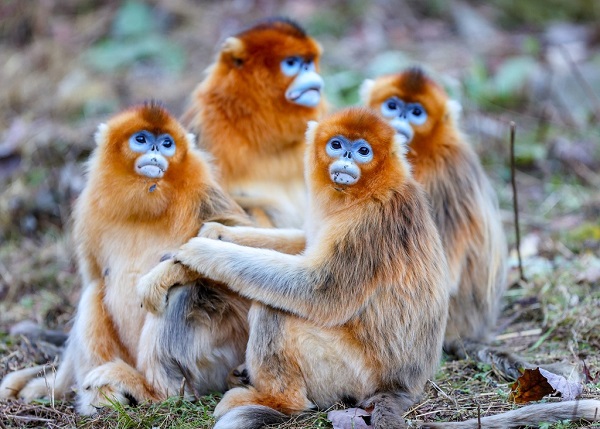Pigmy Marmoset (Cebuella pygmaea)
by: Jonathan Thompson
Taxonomy Description (Pigmy Marmoset)
The Pigmy Marmoset is a primate that is native to South America, with much of its existence documented "throughout the Amazon Rainforest spanning from Rio Caquetá in Colombia, Rio Madeira in Brazil, to Mayo and the Río Huallaga in Peru. (New England Primate Conservancy)
these tiny monkeys are among the smallest primates, growing to approximately 136 mm (5.4 inches) in body length with a weight around 119 grams (4.2 ounces).
taxonomy
- Suborder: haplorrhini (dry-nosed primates)
- Infraorder: Simiiformes (monkey and apes)
- Family: Cebidae (New World Monkey)
- Subfamily: Callitrichnae (Marmosets and tamarins)
- Genus: Cebuella
- Species: Cebuella Pygmae
Common Names
- English: Pigmy Marmoset
- Spanish: Mono de Bolsillo, Leoncillo, Tití, and Chichico
- French: Ouistiti mignon
- Ducth: Dwergzijdeaapje
- Swedish: dvärgmarmosett
Morphology
"Pygmy marmosets are the smallest monkeys in the world, averaging 119 g (4.2 oz) in weight and 136 mm (5.35 in) in body length." (Wisconsin National Primate Research Center) While males and females are nearly identical in size, females tend to be slightly heavier. Their fur is a mix of brownish-gold with black accents on their shoulders, back, and head, while their underside is pale yellow to white. Newborns have a lemon-yellow coat with black highlights, along with a dark gray head and yellow fur surrounding their ears. Within a month, their fur transitions to resemble that of adults. Their long, ringed tails extend beyond their body length, and their faces display distinct white markings, which may help with communication in low-light forest conditions.
"Though they exhibit squirrel-like patterns of locomotion, including quadrupedally running up and down tree trunks, vertically clinging to tree trunks as they feed on sap" (WNPRC) pygmy marmosets are true primates. They navigate their environment by running along branches, clinging vertically to trees, and leaping up to five meters between surfaces. Their sharp, claw-like nails (tegulae) provide a strong grip for climbing, unlike the flat nails seen in many other primates. Additionally, their specialized lower incisors are adapted for gnawing into tree bark to extract sap, a key part of their diet. To aid in digesting plant gums, they have an enlarged cecum, which allows for extended breakdown of these substances. Uniquely, pygmy marmosets frequently give birth to fraternal twins, a rare trait among primates.
Life History
Pygmy marmosets live in family groups, or troops, typically consisting of around five members, though some groups can include up to nine. These troops usually consist of a breeding pair, their offspring, and sometimes adult children. The parents mate for life, and all members contribute to caring for the young. "infants are often born in pairs and nursed by their mothers, carried around by their fathers, and watched over by their siblings." (Smithsonian Magazine)
Lifespan & Development Stages
- Lifespan: In the wild, pygmy marmosets live around 12 years, while those in captivity can live up to 18 years.
- Gestation Period: Females are pregnant for approximately 4.5 months (135 days) and can give birth every 5 to 7 months.
- Birth & Infant Stage: Typically, a mother gives birth to twins, though in captivity, litters of three or four have been recorded. Newborns are extremely small, roughly the size of a human thumb. The father plays a significant role in childcare, assisting with delivery, cleaning, and carrying the infants on his back for the first two weeks. Older siblings also help in raising the newborns.
- Weaning & Subadult Stage: By around three months, young pygmy marmosets are weaned and can follow the troop independently. During this stage, they begin to explore and develop skills needed for survival, such as foraging and communication.
- Adult Stage: Pygmy marmosets reach full size at around two years old. At this point, they may either leave the troop to start their own family or remain to help raise their younger siblings.
Furthermore, pygmy marmosets use high-pitched vocalizations, some beyond the range of human hearing, to communicate within their troop. They also rely on facial expressions, using their lips, eyelids, ears, and facial hair to convey emotions such as contentment, surprise, or fear. Grooming is an important social activity, reinforcing bonds among family members. Additionally, they mark their territory with scent glands to establish boundaries and avoid conflicts with neighboring troops.
Conservation Status:
Pygmy marmosets are small primates native to the Amazon Basin of South America, found in Colombia, Ecuador, Peru, Brazil, and Bolivia. They are highly adaptable and thrive in both primary forests and disturbed habitats. "Their high reproductive rate has contributed to their stable population" (Wisconsin National Primate Research Center), and they are currently classified as
Least Concern by the IUCN. However, ongoing threats such as habitat destruction, capture for the pet trade, and human disturbances from ecotourism could impact their long-term survival.
While deforestation continues to affect many species, pygmy marmosets have managed to persist. However, studies show that frequent interaction with ecotourists alters their behavior, leading to larger home ranges, increased time in higher forest levels, and reduced play. These changes may have long-term effects on their reproductive success. To counter these threats, conservation programs have been established, such as environmental education initiatives in Ecuador, which focus on raising awareness about the importance of pygmy marmoset preservation. Protecting their natural habitat and limiting human interference will be key to ensuring the stability of their wild populations.
_____________________________________________________________________________________
Citations
“Pygmy Marmoset.” San Diego Zoo Wildlife Alliance Animals and Plants, animals.sandiegozoo.org/animals/pygmy-marmoset.
“Pygmy Marmoset.” Wisconsin National Primate Research Center, primate.wisc.edu/primate-info-net/pin-factsheets/pin-factsheet-pygmy-marmoset/.
They’re Adorable. and Endangered. Meet the World’s Smallest Monkey: The Pygmy Marmoset | Smithsonian, www.smithsonianmag.com/science-nature/adorable-endangered-worlds-smallest-monkey-pygmy-marmoset-180985628/.
“Western Pygmy Marmoset, Cebuella Pygmaea - New England Primate Conservancy.” New England Primate Conservancy - Committed to Leaving a Legacy of Hope and Tools to Build a Better Tomorrow for All the Earth’s Citizens, 10 May 2024, neprimateconservancy.org/western-pygmy-marmoset/.






Comments
Post a Comment